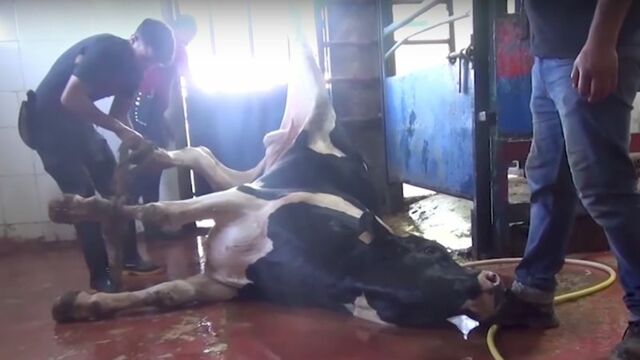Discover our latest podcast
One cow left out in the sun without food or water, another forced to wander in between corpses of other animals, a bull strung up by one hoof, its throat slit several times… Once they cross the borders of the European Union, the truth about what happens to these animals we export ‘remains hidden from the rest of the world,’ as the Welfarm organisation, who published this shocking footage filmed by the Animals International organisation in Tunisia and Lebanon, told Le Monde.
In a letter addressed to French Prime Minister, Edouard Philippe, five organisations have demanded that the government impose a law forbidding the exportation of live animals to countries that cannot guarantee that they will respect European rules and regulations.
A ‘horrific’ slaughterhouse
‘I have visited lots of slaughterhouses around the world, but what I saw in this one was the most chaotic and horrific one yet,’ revealed Gabriel Paun, the director of Animal International, to Le Monde. He explained how shocked he was by the treatment that an older cow, whose origin was traced back to Ain in France, was subjected to in a Moroccan slaughterhouse. It was forced to trample on and walk among other animal corpses that were scattered across the floor and that it was also left out in direct sunlight without food or water.
We are not going to reveal the footage in question in this article, but if you want to see it for yourself, click HERE and HERE. Warning, this footage does contain content which may be upsetting or distressing for some viewers.
In the footage in the links above, you can also find more scenes which are particularly violent. In one of them, which was filmed in Lebanon last year, a young bull, originally born in Ardennes in France, can be seen lying on the ground with one of its back legs attached to the ceiling by a rope. To get it to move, one man pulls on this rope while another sticks his fingers into the bull’s eyes. They then slit the cow’s throat once but end up slitting the poor beast’s throat several times before it eventually dies.
‘The World Organisation for Animal Health standards stipulate that the method used for slaughter should result in immediate death or immediate loss of consciousness,’ as Le Monde reported recently. In France, cattle breeders are still unaware of the fate in store for their animals when they are sold on to third parties.
Meat marketed as ‘local’
According to Le Monde, in 2018, France exported almost 100,000 animals to third world countries, in other words, countries outside of the European Union. And this market is increasing, so much so that the number of animals which will be exported to these countries is said to double over the next six years, particularly to Morocco and Algeria.
For these countries, this market has lots of benefits and value. The market creates more jobs for locals, in slaughterhouses for example, and in other markets due to the value of some parts of the animals such as their skin, as well as evisceration and in the way, the slaughter market is controlled and moderated so they can sell the meat as ‘locally sourced’.















